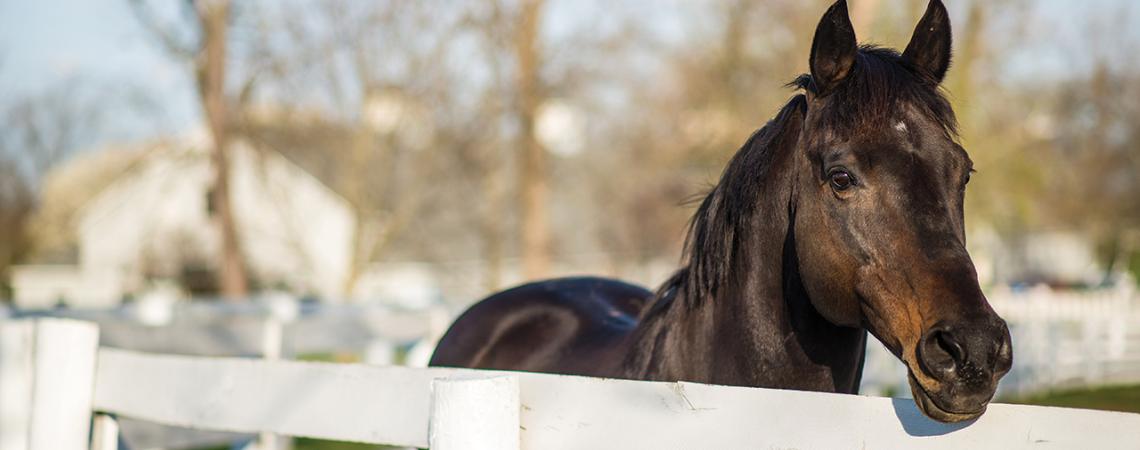Go For Gin, the second-oldest living Kentucky Derby winner, greets visitors daily to his home in Kentucky Horse Park. (Photo by James Shambhu, courtesy of Kentucky Horse Park.)
The horse is Kentucky’s icon, and no place celebrates all things equine better than Kentucky Horse Park.
Located just outside Lexington, the park is like Disneyland with horses. Pristine grounds and specially designed buildings echo the beauty of the surrounding Bluegrass horse country, while programming and activities harness humanity’s relationship with horse breeds throughout the globe.
Although it is owned by the Commonwealth of Kentucky, its pedigree began in Virginia in 1777, when Governor Patrick Henry granted thousands of acres in the Kentucky Territory to a Revolutionary War veteran, Col. William Christian. Subsequent owners raised Thoroughbreds and Standardbreds on that land, and John R. Gaines of Lexington’s Gainesway Farm put forth an idea for an equine-themed park and followed through to spur its development as a public-private partnership.
Since its opening in 1978, Kentucky Horse Park has grown into a multifaceted facility that combines a working farm with equestrian venues that host prestigious competitions, such as the Kentucky Three-Day Event, a world-class dressage, cross-country, and jumping triathlon. It’s also home to top equine associations, museums, a campground, and, between April and October when operations are in full swing, more than 100 horses. The park turns 40 in 2018, so it’s an ideal time to enjoy its unparalleled brand of horseplay. Here’s a quick guide to its attractions and experiences.
Hall of Champions presentations
Retired racing elites like Kentucky Derby winner Funny Cide charm fans and relish attention during appearances at the Hall. “These horses all have presence,” says manager Rob Willis. “Everything in their DNA is firing on the right cylinders. That’s why they’re here.” Point Given, the 2001 American Horse of the Year, debuts this month.
The art of legends
At the park’s entrance, a magnificent bronze of Man o’ War marks the resting place of the legendary racehorse. Additional sculptures throughout the park portray equine immortals such as Secretariat, Supreme Sultan, and Misty, the Chincoteague Pony popularized in children’s literature.
Breeds Barn and Parade of Breeds
The park typically has 30 to 40 different horse breeds in residence, including familiar ones like the Quarter Horse and Morgan Horse, as well as rare Marwari from India and Akhal-Teke from Turkmenistan. Entertaining parade of breeds shows highlight horses and their traditional home turf with colorfully costumed riders — think knights riding English Shires, Vikings on Norwegian Fjords, and Native Americans astride Appaloosas.
International Museum of the Horse
Covering 50 million years of equine history, exhibits range from horses in Chinese art to the newly opened “Black Horsemen of the Kentucky Turf.” A popular exhibit is “Calumet Farm’s Trophies,” a true Bluegrass treasure that includes 560 spectacular trophies that attest to the Lexington farm’s decades of dominance in Thoroughbred breeding and racing.
Visitor Information Center and gift shop
Stop here to get a park map, review the day’s schedule of activities, and plan your visit. “You can’t just spend an hour at the park,” advises Breeds Barn manager Shelli Wright. “You have to spend the day, because everything here teaches you something about horses.” The center offers a fine introductory film, Rein of Nobility, and the gift shop boasts the nation’s largest permanent selection of Breyer model horses. While you’re there, make sure to ask about the narrated horse-drawn trolley tours; riding a trolley pulled by Draft Horses is a fun way to get acquainted with the park’s main attractions.
The Big Barn
The barn dates to 1897 and was the site of Kentucky’s first Standardbred sales. Now housing Draft Horses, it hosts meet-and-greets so visitors can appreciate these gentle giants. “When people stand beside a Draft Horse and realize how big they are, it’s like they’re seeing the ocean or Grand Canyon for the first time,” says assistant Equine Operations director Sheila Forbes.









